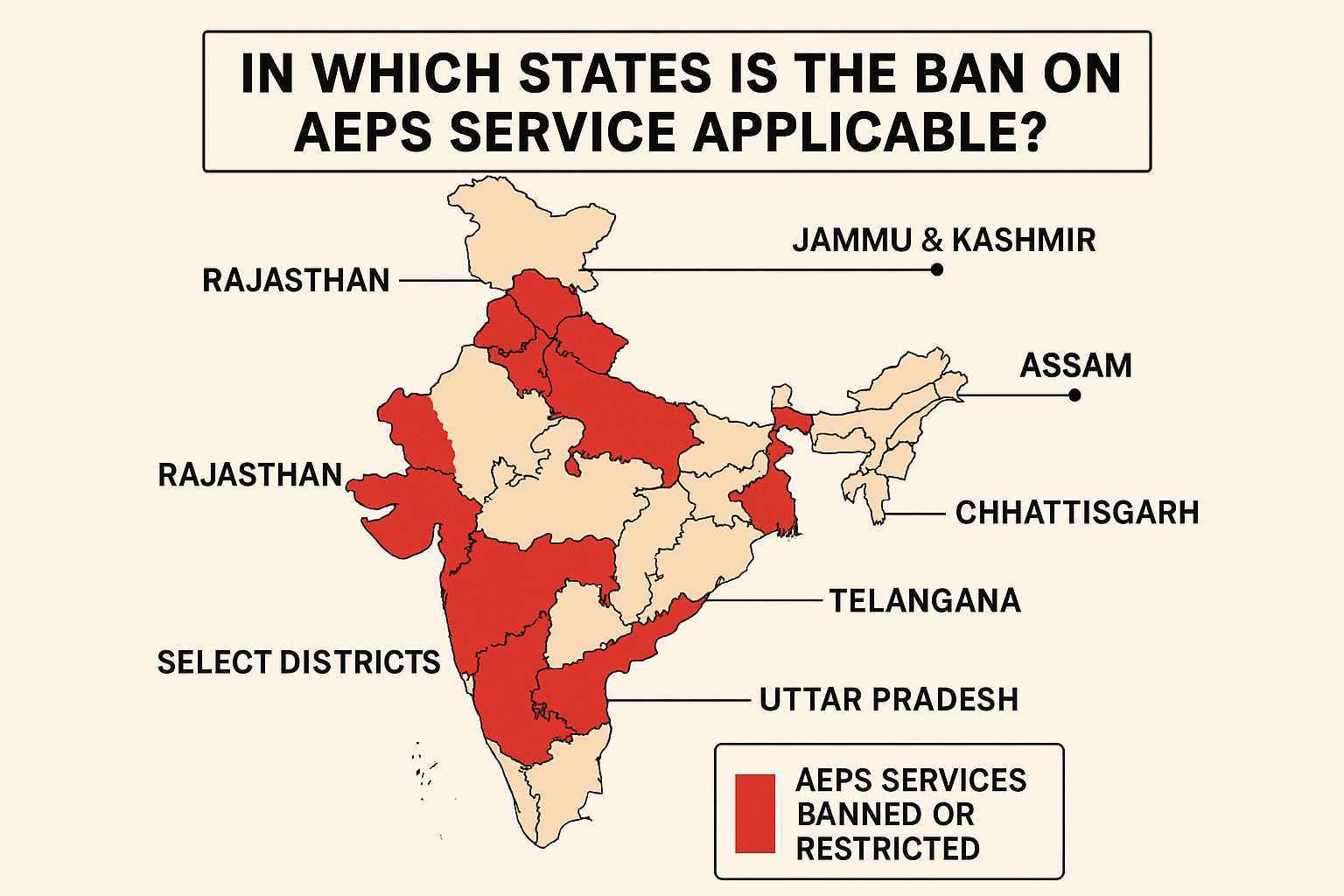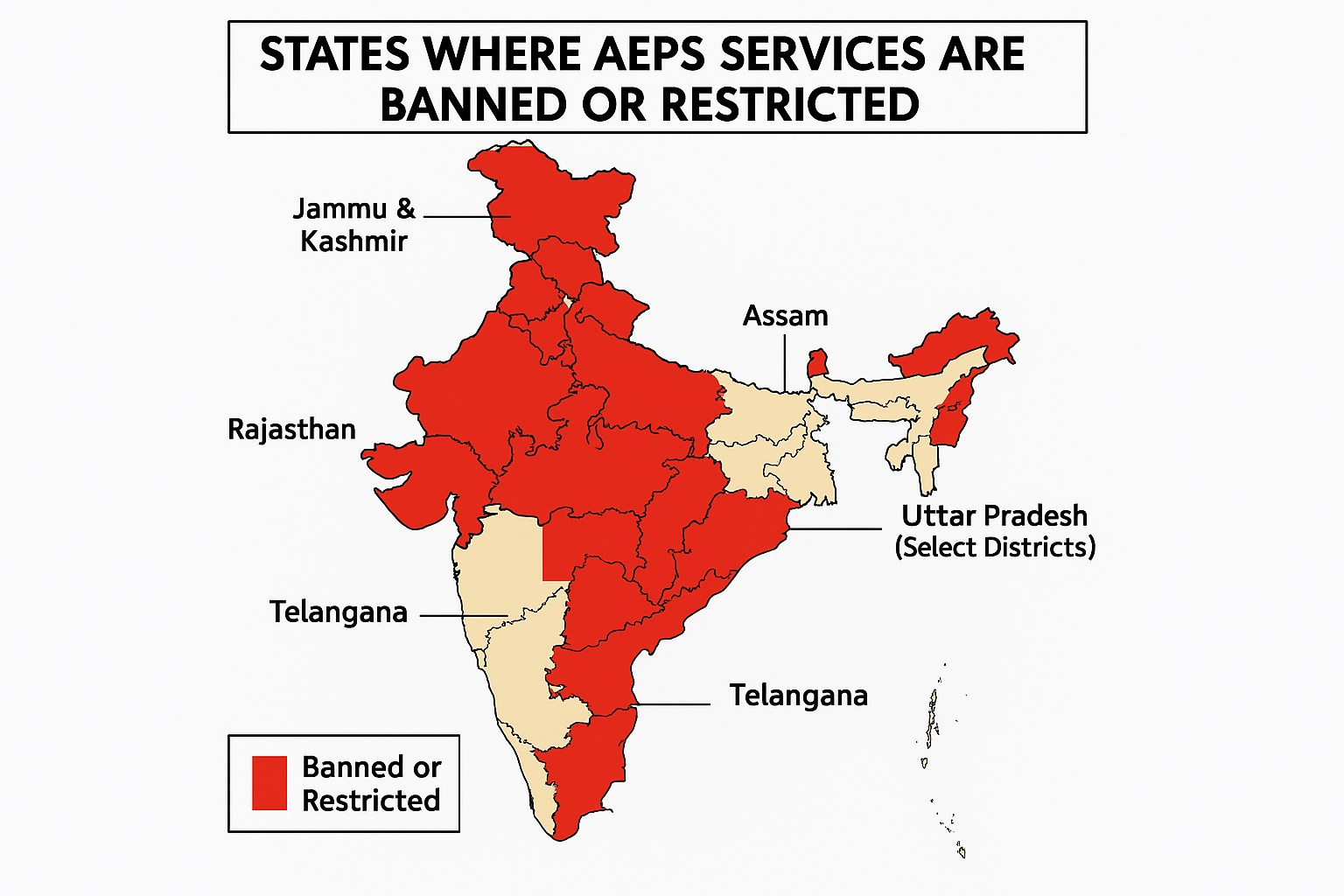The Aadhaar Enabled Payment System (AEPS) has revolutionized digital banking in India, allowing millions to access financial services using just their Aadhaar number and biometric authentication. However, despite its widespread adoption, certain states have imposed restrictions or outright bans on AEPS services due to security concerns, fraud risks, or regulatory issues.
If you’re wondering, “In which states is the ban on AEPS service applicable?”, this article provides a detailed breakdown of the current status, reasons behind the bans, and what it means for users.
Understanding AEPS and Its Importance
Before diving into the banned states, it’s essential to understand what AEPS is and why it matters.
-
What is AEPS?
AEPS is a bank-led payment system that enables Aadhaar-linked transactions such as cash withdrawals, deposits, balance checks, and fund transfers using biometric authentication (fingerprint/iris scan). -
Why is AEPS Popular?
-
No need for debit cards, PINs, or mobile phones.
-
Ideal for rural areas with limited banking infrastructure.
-
Supports financial inclusion for the unbanked population.
-
However, despite its benefits, AEPS has faced challenges, including fraud, security breaches, and misuse, leading some states to restrict or ban its services.

States Where AEPS Services Are Banned or Restricted
As of 2024, several Indian states have imposed partial or complete bans on AEPS due to rising fraud cases and security concerns. Here’s a breakdown:
1. Jammu & Kashmir
-
Reason for Ban: Security concerns and misuse by unauthorized entities.
-
Current Status: AEPS services are heavily restricted, with transactions requiring additional verification.
2. Assam
-
Reason for Ban: High instances of fraudulent transactions linked to AEPS.
-
Current Status: Temporary restrictions in certain districts; full ban under consideration.
3. Chhattisgarh
-
Reason for Ban: Reports of AEPS being exploited for illegal transactions.
-
Current Status: Limited functionality; stricter KYC norms in place.
4. Telangana
-
Reason for Ban: Rising cases of biometric fraud and identity theft.
-
Current Status: Some banks have suspended AEPS services in rural areas.
5. Rajasthan
-
Reason for Ban: Multiple scams involving AEPS-based withdrawals.
-
Current Status: Partial restrictions; transactions above a certain limit require OTP verification.
6. Uttar Pradesh (Select Districts)
-
Reason for Ban: Misuse by cybercriminals in rural banking scams.
-
Current Status: AEPS services suspended in high-risk zones.
Why Are States Banning AEPS?
Several factors contribute to the restrictions:
-
Rising Fraud Cases
-
Criminals clone fingerprints or use fake biometric data to withdraw money.
-
Example: In Assam, ₹50 crore was stolen via AEPS fraud in 2023.
-
-
Lack of Strong Authentication
-
Unlike UPI or card transactions, AEPS relies solely on biometrics, making it vulnerable.
-
-
Regulatory Pressure
-
RBI and state governments have raised concerns over security loopholes.
-
-
Cybercrime Syndicates
-
Organized gangs exploit AEPS for large-scale financial fraud.
-
What Does This Mean for Users?
If you live in a state where AEPS is banned or restricted, here’s what you should know:
-
Alternative Banking Methods: Use UPI, debit cards, or USSD-based banking.
-
Enhanced Security: Enable two-factor authentication where possible.
-
Stay Updated: Check with your bank for the latest AEPS guidelines in your state.

Future of AEPS in India
While AEPS remains a crucial tool for financial inclusion, stricter regulations are expected. The government is working on:
-
Biometric Encryption: Making fingerprint data more secure.
-
Fraud Detection Systems: AI-based monitoring to detect suspicious transactions.
-
Multi-Factor Authentication: Combining biometrics with OTP for added security.
Frequently Asked Questions (FAQs)
Q1. Is AEPS completely banned in India?
No, AEPS is operational in most states, but some have imposed restrictions due to fraud risks.
Q2. Can I still use AEPS in banned states?
In restricted areas, transactions may require additional verification or may be blocked entirely.
Q3. What is the safest alternative to AEPS?
UPI (like PhonePe, Google Pay) and USSD banking (*99#) are secure alternatives.
Q4. Will AEPS be permanently banned?
Unlikely. The government is working on improving security rather than discontinuing the service.
Conclusion
The ban on AEPS services in certain states highlights the growing challenges of digital financial fraud. While restrictions are in place to protect users, AEPS remains a vital tool for financial inclusion. Staying informed about local regulations and adopting secure banking practices can help mitigate risks.
For now, if you’re in a state where AEPS is banned, explore alternative banking methods and keep an eye on official updates from banks and the RBI.
Disclaimer
This article is for educational purposes only. If you have any concerns regarding the content, please refer to our DMCA page for removal requests. Always verify the latest banking regulations from official sources before making financial decisions.
